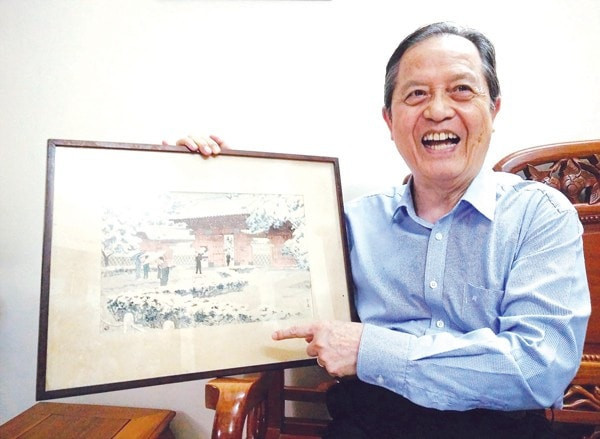On the occasion of the Lunar New Year, Professor Dang Luong Mo, a leading expert in the field, spoke with Hanoimoi about Vietnam’s opportunities and challenges in the global semiconductor race.
A rare opportunity in the global semiconductor race

Photo: Intel Products Vietnam.
Professor Dang Luong Mo noted that since the U.S. lifted its embargo on Vietnam on September 2, 1994, the country has had three significant opportunities to establish a full-fledged semiconductor industry.
Unfortunately, Vietnam missed out on all three due to various reasons.
This time, however, the government has taken a decisive step forward.
On September 21, 2024, Prime Minister Pham Minh Chinh signed Decision No. 1018/QD-TTg, approving Vietnam’s Semiconductor Industry Development Strategy through 2030, with a vision for 2050.
“This is both an opportunity and a challenge that will allow Vietnam to confidently enter a new technological era,” Professor Mo remarked.
Vietnam has increasingly attracted interest from major global semiconductor companies looking to establish research and production facilities in the country.
Companies like Renesas (Japan), Intel (U.S.), and Samsung (South Korea) have had a presence in Vietnam for years.
However, their operations have been limited to design, testing, and packaging rather than full-scale semiconductor manufacturing.
For Vietnam to develop a comprehensive semiconductor industry, it must go beyond design and testing to invest in fundamental areas such as semiconductor materials and chip fabrication.
“In the 1950s, Japan took its first steps in semiconductor production, and decades later, South Korea followed suit. Today, these countries lead in microchip manufacturing, producing cutting-edge 1.8-nanometer semiconductor technology. They succeeded because they invested heavily in materials research and manufacturing,” Professor Mo explained.
Recent visits from industry giants like NVIDIA (U.S.) and ASML (Netherlands) have sparked optimism.
On December 5, 2024, Vietnam and NVIDIA signed a cooperation agreement to develop an AI Research and Development Center in Vietnam.
Professor Mo believes this milestone will significantly boost Vietnam’s semiconductor ambitions and attract further high-tech investments, particularly in artificial intelligence.
The path to a $25 billion semiconductor industry

Vietnam’s Semiconductor Industry Development Strategy sets ambitious goals.
By 2030, the industry aims to generate more than $25 billion in annual revenue, with Vietnam’s added value ranging from 10% to 15%.
To put this into perspective, the global semiconductor industry was valued at $611.35 billion in 2023 and is projected to reach $2.06 trillion by 2032, according to Fortune.
With a population of over 100 million - approximately 1.14% of the global total - Vietnam’s fair share of the semiconductor market would be around $7.75 billion annually.
Achieving the $25 billion revenue target would position Vietnam well beyond being a mere outsourcing hub for foreign companies.
However, reaching this goal requires Vietnam to develop not only chip design capabilities but also expertise in semiconductor materials and manufacturing.
“Countries like Japan and South Korea achieved semiconductor success by investing their own resources rather than waiting for foreign investment to take the lead. Vietnam must adopt the same approach mobilizing domestic resources efficiently while minimizing waste and inefficiencies,” Professor Mo emphasized.
The role of education in semiconductor growth
Vietnamese universities have recently accelerated the establishment of semiconductor and microchip design programs.
However, Professor Mo stressed that training efforts must go beyond chip design to encompass the entire semiconductor supply chain, including materials research and fabrication.
“In Japan, South Korea, and other East Asian nations, both governments and universities play a direct role in semiconductor industry development. Governments provide financial support and policy incentives, while universities drive research and workforce training across all aspects of the industry,” he explained.
Developing a skilled semiconductor workforce will require long-term commitment, possibly spanning decades.
Despite the challenges, Professor Mo remains optimistic about Vietnam’s future in the global semiconductor landscape.
About Professor Dang Luong Mo
Born in 1936, Professor Dang Luong Mo has spent much of his career in Japan and is currently a senior advisor at the Integrated Circuit Design Research and Education Center (ICDREC) under the Vietnam National University – Ho Chi Minh City.
With over 300 research projects and 13 internationally recognized patents, he has been honored by various global institutions.
He is a Fellow of the New York Academy of Sciences and a senior member of the Institute of Electrical and Electronics Engineers (IEEE).
In 2004, he received the Vietnam Honor Award for his contributions to the country.
For his specific contributions to Vietnam’s semiconductor industry, he was awarded the Third-Class Labor Medal by the President of Vietnam on September 2, 2015.
Hanoimoi